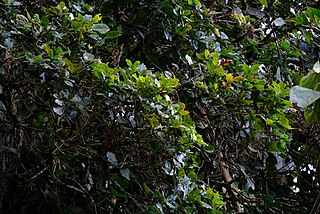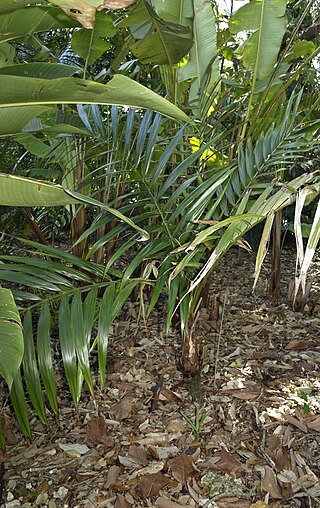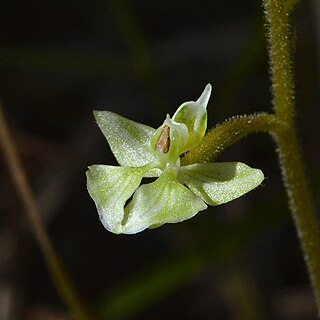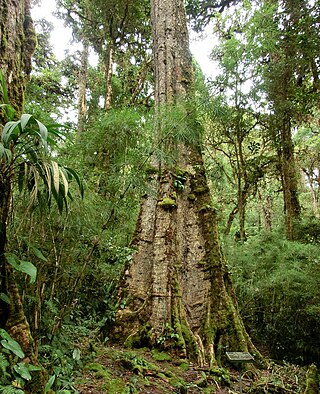
Chusquea is a genus of evergreen bamboos in the grass family. Most of them are native to mountain habitats in Latin America, from Mexico to southern Chile and Argentina.
Astrocasia is a plant genus of the family Phyllanthaceae first described as a genus in 1905. It is included in the subtribe Astrocasiinae. It is native to Mesoamerica, northern South America, and the western part of the West Indies. Plants are mostly dioecious, except for Astrocasia diegoae which is monoecious, and some individuals of A. neurocarpa and A. tremula.
- Astrocasia austinii(Standl.) G.L.Webster - Izabal
- Astrocasia diegoaeJ.Jiménez Ram. & Mart.Gord. - Guerrero
- Astrocasia jacobinensis(Müll.Arg.) G.L.Webster - Bahia, Bolivia
- Astrocasia neurocarpa(Müll.Arg.) I.M.Johnst. ex Standl. - Oaxaca, Querétaro, San Luis Potosí, Tamaulipas
- Astrocasia peltataStandl. - Costa Rica, Nayarit, Jalisco
- Astrocasia tremula (Griseb.) G.L.Webster - Mexico, Central America, West Indies, northern South America

Calyptrogyne is a genus in the palm family (Arecaceae). It is distributed across Central America, Colombia, and southern Mexico, with 11 of the 17 known species endemic to Panama. Calyptrogyne ghiesbreghtiana is the most widespread and best studied species in this genus.

Quercus copeyensis is a species of oak endemic to the Talamancan montane forests of Costa Rica and Panama. It is commonly called Panamanian oak.

Spathiphyllum montanum is a flowering plant of the genus Spathiphyllum in the family Araceae. It is native to Panama and Costa Rica.

Astrocaryum alatum is a species of palm with edible nuts, a flowering plant in the family Arecaceae. It is a common species found many types of rainforests and swamps in Honduras, Costa Rica, Nicaragua and Panama.
Thoracocarpus is a genus of plants first described as a genus in 1958. It contains only one known species, Thoracocarpus bissectus a hemiepiphytic vine. It is native to Costa Rica, Panama, Cuba, Trinidad and Tobago, and South America.

Welfia is a genus of palms found in Central America and northwestern South America. Only two species are currently recognized: Welfia regia and Welfia alfredii.

Neonicholsonia is a monotypic genus of flowering plant in the palm family native to Central America. The sole species is Neonicholsonia watsonii. The genus and species names honor George Nicholson, a former curator of the Royal Botanic Gardens, Kew and his successor William Watson.

Ponthieva racemosa, commonly called the hairy shadow witch or racemose ponthieva, is a species of orchid found from the southeastern United States, Mexico, Central America, the West Indies and northern South America as far south as Bolivia.

Aechmea dactylina is a plant species in the genus Aechmea. This species is native to Costa Rica, Nicaragua, Panama, Colombia and Ecuador.

Cischweinfia is a genus of flowering plants from the orchid family, Orchidaceae. It was named after Harvard orchidologist Charles Schweinfurth. It has eleven currently recognized species, all native to Central America and northwestern South America.

Warrea is a genus of flowering plants from the orchid family, Orchidaceae. It has three known species, all native to Latin America.
Systeloglossum is a genus of flowering plants from the orchid family, Orchidaceae. It contains 5 known species, all native to southeastern Central America and northwestern South America.
- Systeloglossum acuminatumAmes & C.Schweinf. - Costa Rica, Panama
- Systeloglossum bennettii(Garay) Dressler & N.H.Williams - Peru
- Systeloglossum costaricenseSchltr. - Peru
- Systeloglossum ecuadorense(Garay) Dressler & N.H.Williams - Ecuador
- Systeloglossum panamenseDressler & N.H.Williams - Panama

Brachystele guayanensis is a species of orchid. It is native to southern Mexico, Central America, Trinidad & Tobago, and northern South America.

Beloglottis costaricensis is a terrestrial species of orchid. It has a wide distribution, reported from Mexico, Central America, the West Indies, South America, and Dade County Florida.
Chorigyne is a genus of plants first described as a genus in 1989. All the known species are native to Costa Rica and Panama.
Brickellia argyrolepis is a Mesoamerican species of flowering plants in the family Asteraceae. It is native to Central America and to southern Mexico.

Quercus salicifolia is a species of oak. It is native to central and southern Mexico and Central America, from Jalisco to Panama.

Quercus sapotifolia is a species of oak. It is native to southern and western Mexico as well as Central America. It is threatened by habitat loss.

















